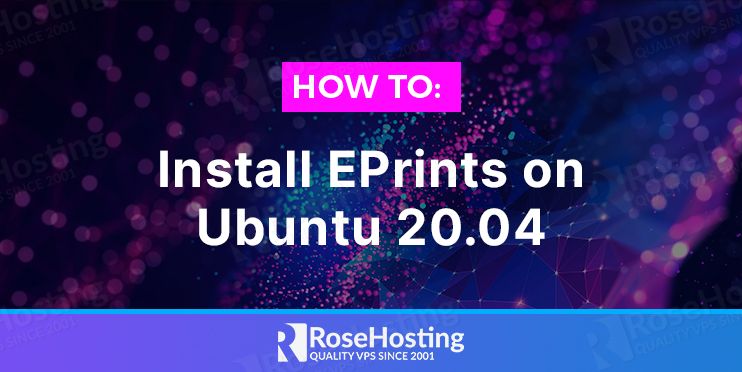
EPrints is open-source software designed for building open access repositories that are OAI-PMH compliant. It is primarily used for scientific journals and institutional repositories although it can be also used as a document management system.

It is based on LAMP architecture, but with Perl instead of PHP.
EPrints consists of Web and command-line application which offers a wide range of plugins and addons available. So let’s get started with the installation!
Table of Contents
Table of contents
Prerequisites
- For the purposes of this tutorial, we will use an Ubuntu20.04 VPS.
- Access to the root user account (or a user with sudo privileges)
Step 1: Log in to the Server & Update the Server OS Packages
As always, first log in to your VPS via SSH:
ssh user@hostnameOnce you are in, run the following commands to update the package index and upgrade all installed packages to the latest available version.
sudo apt-get update
sudo apt-get upgradeStep 2: Installing LAMP stack
LAMP (Linux, Apache, MySQL, Perl) is a combination of open-source software stacks required to run the EPrints application.
The Apache web server can be easily installed with:
sudo apt-get install apache2Once the installation is complete, enable the Apache service to start automatically upon system boot.
sudo systemctl enable apache2The next step is to install MySQL. It is one of the most popular database management systems and offers a lot of functionality with managing and configuring databases.
To install MySQL on your system, type the following command and enter Y when prompted:
sudo apt-get install mysql-serverLast in this step is to install Perl, which comes installed with Ubuntu 20.04 by default, but if you don’t have Perl installed on your system you can install it with the following command:
sudo apt install perlStep 3: EPrints installation
You will first need to add the EPrints package repository to your Ubuntu server with the following command:
echo "deb http://deb.eprints.org/3.4/stable/ ./" > /etc/apt/sources.list.d/eprints.listYou can proceed with adding the GPG key and then updating the repositories with the commands:
wget -O - http://deb.eprints.org/keyFile | apt-key add -
apt-get updateNow you can install the EPrints package.
apt-get install eprintsWhen the installation is finished you can find Eprints installed to /usr/share/eprints. However, you still won’t have a running archive.
Before we create the archive, “epadmin create” runs at the eprints user, this will not be able to create a database for EPrints. That’s why we will create the EPrints user in MySQL and grant him permissions.
First login into MySQL with your root user, if you still haven’t set a password for your root user you can log in with:
mysql -u rootThis will take you to the MySQL Command-Line Tool, here you can create the eprints user and grant him permissions. Please don’t forget to change the ‘changeme’ with your real password:
CREATE USER 'eprints'@'localhost' IDENTIFIED by 'changeme';
GRANT ALL PRIVILEGES ON *.* TO 'eprints'@'localhost' WITH GRANT OPTION;
flush privileges;
You may also want to restrict which databases the EPrints user has control over if you know the “Archive ID” you are going to use.
Now you can proceed to create your first archive. Start by changing to the EPrints user and navigating to the /usr/share/EPrints directory:
su eprints
cd /usr/share/eprintsYou can start with archive creation with:
./bin/epadmin create zeroThis will the script with a number of configurations, you can check the example below or you can choose your own configuration:
-bash-4.1$ ./bin/epadmin create
Create an EPrint Repository
Please select an ID for the repository, which will be used to create a directory
and identify the repository. Lower case letters and numbers, may not start with
a number. examples: "lemurprints" or "test3"
Archive ID? testrepo
Configure vital settings? [yes] ? ENTER
Core configuration for testrepo
Hostname? testprint
Webserver Port [80] ? ENTER
Enter a single hash (#) when you're done.
Alias (enter # when done) [#] ? testprint.local
Redirect testprint.local to testprint [yes] ?
Alias (enter # when done) [#] ? ENTER
Path [/] ? ENTER
HTTPS Hostname [] ? ENTER
Administrator Email? someone@example.com
Archive Name [Test Repository] ? ENTER
Organisation Name [Organisation of Test] ? ENTER
Write these core settings? [yes] ? ENTER
Configure database? [yes] ?
Configuring Database for: testrepo
Database Name [testrepo] ? ENTER
MySQL Host [localhost] ? ENTER
You probably don't need to set socket and port (unless you do!?).
MySQL Port (# for no setting) [#] ? ENTER
MySQL Socket (# for no setting) [#] ? ENTER
Database User [testrepo] ? ENTER
Database Password [nxxxxuAw] ? ENTER
Database Engine [InnoDB] ? ENTER
Write these database settings? [yes] ? ENTER
Create database "testrepo" [yes] ? ENTER
Database Superuser Username [root] ? eprints
Database Superuser Password? nxxxxuAw #the same password previously
Create database tables? [yes] ? ENTER
Create an initial user? [yes] ? ENTER
Enter a username [admin] ? ENTER
Select a user type (user|editor|admin) [admin] ? ENTER
Enter Password? 'Choose_your_user_password'
Email? first.last@example.org
Successfully created new user:
ID: 1
Do you want to build the static web pages? [yes] ? ENTER
Do you want to import the LOC subjects? [yes] ? ENTER
You must restart apache for any changes to take effect!
For the changes to take effect exit the EPrints user and restart the apache2 service.
Now you can disable the default web page and enable the EPrint’s configuration on Apache, don’t forget to restart the service at the end. You can do that with the following commands:
a2dissite 000-default.conf
a2ensite eprints.conf
systemctl restart apache2That’s it! The installation of EPrints on Ubuntu 20.04 has been completed, and you can now access the EPrint’s page with your IP address URL, http://IP_ADDRESS on your favorite web browser.
Of course, you don’t need to install EPrints on Ubuntu 20.04 yourself if you use one of our fully managed VPS Hosting services, in which case you can simply ask our expert Linux admins to install and configure it for you. They are available 24×7 and will take care of your request immediately.

P.S. If you liked this post on how to install EPrints on Ubuntu 20.04 please share it with your friends on the social networks by using the share shortcuts below, or simply leave a comment in the comments section. Thanks